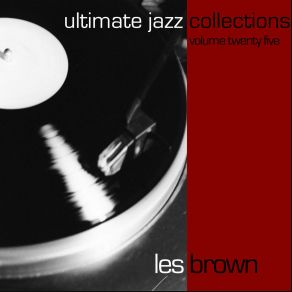Les Brown
Wikimp3 information about the music of Les Brown. On our website we have 64 albums and 70 collections of artist Les Brown. You can find useful information and download songs of this artist. We also know that Les Brown represents Jazz genres.
Biography
[Edit]The leader of a first-class jazz-oriented dance band for over 60 years, Les Brown's music was never innovative but was generally quite pleasing. Brown was born in Reinerton, PA, into the family of a baker. He got started in music early, taking up the saxophone at age seven with the strong encouragement of his father, who played the trombone. He knew how to sight-read before he was ten, and was playing alongside his father by that time at local dances. Brown left high school after one year, choosing instead to attend the Ithaca Conservatory of Music, where he studied theory, harmony, and composition. He passed through the New York Military Academy before landing at Duke University, where he joined the Duke Blue Devils, the university's official dance band, in 1935. Their sound was modeled after the Casa Loma Orchestra, which was then one of the most popular dance bands in the country, especially among college audiences.
Brown made his first recordings as a member of the Blue Devils in 1936 for Decca, but by the following year they'd split up, as the members who were still undergraduates returned to school. Brown went to New York and spent a year working for Jimmy Dorsey, Isham Jones, and Larry Clinton as an arranger. His chance at forming a new band came in 1938 when an executive at RCA arranged a booking for him at the Hotel Edison in Manhattan, if he could put a group together. Brown secured a loan from his father to get the band off the ground and he soon had a 12-piece outfit playing at the hotel. A series of regular live radio broadcasts of the band soon had their reputation spreading far beyond the ranks of the hotel's dance patrons, and RCA Victor quickly signed them to its Bluebird imprint.
The group was doing well as the 1930s closed out, drawing a healthy dance audience and a substantial listenership. Their records weren't the most ambitious in the world — mostly covers of standards and other bands' hits, interspersed with an occasional Les Brown original — but they sold well enough to keep the recording industry interested in them. In the late '30s, most of their sound was built on ensemble playing, and they displayed a rich, full tone that came off well, both in person and over the air as well as on record. Brown insisted on a polished, precise sound and audiences seemed to devour it. But starting in 1940, he began altering their sound by allowing room for his soloists to go to work doing that they did best, and audiences liked it even better. Then he hired his first vocalist, a teenager named Doris Day, who sang with a depth and level of sophistication far beyond her 17 years, and their popularity soared. Day's first stay with the group wasn't long — less than a year — before she left to get married. Her replacement, Betty Bonney, was aboard when the band cut a song devoted to the then-current phenomenon of Joe DiMaggio's hitting streak — "Joltin' Joe DiMaggio" became their first chart hit. When the smoke cleared, the band found itself ranked among the top ten most popular performing outfits in the country.
It was a radio show, Spotlight Band, that inadvertently played a big role in their subsequent history. The Les Brown band appeared regularly on the program, which went to service audiences around the country (and made them permanent favorites of millions of men in uniform). But it was a chance moment in 1942, when an announcer referred to them as "Les Brown & His Band of Renown," that proved a key to their future. The reference sounded great, and it stuck, and it became the band's permanent name. They came to occupy a peculiar niche in the musical world as it existed in those years — although it wasn't really a jazz band, Brown's group employed enough elements of jazz, and enough high-quality soloists (and Brown seldom featured himself in the latter capacity, though he was a good player), that they were treated with a great deal of respect by jazz players and in the jazz journals of the period.
The next pivotal moment came in 1943 when Brown persuaded Doris Day, now divorced and raising a son (actually, future producer Terry Melcher), to return to the band. The result, in 1944, was one of the most enduring hits of World War II, "Sentimental Journey." It not only became one of the defining hits of the big-band era, but also Brown's signature tune (and, to a lesser degree, Day's signature tune) for the next 50 years, and even in the 21st century is totally identified with both of them. The song was written by Ben Homer, a composer and arranger who was also responsible for the various dance adaptations of classical works that Brown's band recorded. Brown spent most of the 1940s signed to Columbia Records, which was also the home of Doris Day as a solo act. Brown's career momentum was slowed only when the Second World War drew to a close, and he decided to spend more time with his wife and family, which meant giving up touring — he'd had some excellent soloists in his band, including Abe Most and Ted Nash, but they soon began drifting away to other work once Brown settled down in Los Angeles.
In early 1947, Brown took on an extended engagement at the Hollywood Bowl, which resulted in his reactivating the band in a new incarnation, made up of freelancers — he also discovered that there were enough truly high-caliber examples of the latter that the music didn't suffer at all. As a result of that engagement, he also picked up what proved to be the longest running gig of his career when he started working with Bob Hope. The association with Hope — which resulted in Brown touring for many years in tandem with the legendary comedian's performances on behalf of American servicemen — made it possible for the orchestra to stay together for many decades. The Dave Pell Octet, which was quite popular in the mid-'50s, was comprised of some of Brown's sidemen. In the late '50s, Brown became one of the founding members of the Recording Academy. Brown was signed to Capitol Records during this same period and enjoyed a fresh string of hit singles and successful LPs through the end of the decade — such was his reputation that he was easily able to recruit top players (such a reedman Billy Usselton) for those later bands, and those Capitol recordings have found an enduring audience much as his earlier Columbia sides did. Additionally, his work with Hope helped to keep his name alive for several generations of television viewers, among others, well into the 1980s. Brown also occasionally toured throughout the last decades of his life, even performing within a year of his death on January 4, 2001, at the age of 88. His son, Les Brown, Jr., a musician who was primarily known as an actor, took over the Band of Renown during the 21st century and has kept it going since. ~ Scott Yanow & Bruce Eder, Rovi
Title: Sing Sing Sing (Remastered) (3 Min Version) - Single
Artist: John Pizzarelli, Les Brown
Genre: Pop
Title: Vintage Dance Orchestras No. 302 - EP: Love Letters In The Sand
Artist: Les Brown
Genre: Jazz
Title: The Keen Collection of Big Band, Vol. 1
Artist: Mills Blue Rhythm Band, Les Brown, Don Redman, Don Redman And His Orchestra
Genre: Jazz
Title: The Keen Collection of Big Band, Vol. 3
Artist: Mills Blue Rhythm Band, Les Brown, Don Redman And His Orchestra
Genre: Jazz
Title: Greatest Classics: Les Brown, Artie Shaw, Stan Kenton
Artist: Stan Kenton, Artie Shaw, Les Brown
Genre: Jazz
Title: Step Into Your Greatness - The Les Brown Smoothe Mixx
Artist: Les Brown, Roy Smoothe
Genre: Hip Hop/R&B, Soul
Title: The Les Brown Story Life Lessons from the Man Behind the Motivation
Artist: Les Brown
Genre: Gospel
Title: The Keen Collection of Big Band, Vol. 2
Artist: Mills Blue Rhythm Band, Les Brown, Don Redman, Don Redman And His Orchestra
Genre: Jazz
Collections
Title: 123 Classic Hits from the Early 1950's
Genre: Pop
Title: Us Groovy Vol. 2
Genre: Pop
Title: The Golden Dozen the Best of Jule Styne
Genre: Pop
Title: And Now Halloween (The Best Classic Songs)
Genre: Pop
Title: Big Band Remixed & Reinvented
Genre: Electronica, Jazz
Title: 16 Most Requested Songs: The 1940s, Vol. 1
Genre: Pop
Title: A Variety of Hits, Vol. 1
Genre: Pop
Title: C-H-R-I-S-T-M-A-S
Genre: Traditional Pop Music
Title: Hits of the 1940's
Genre: Pop
Title: Jazz Greats - The Women of Jazz
Genre: Jazz
Title: 100 Easy Listening Instrumental Songs
Genre:
Title: Chart-Toppers of the '40s
Genre: Jazz
Title: 50 Big Bands and the Best Swing for Dancing
Genre: Jazz
Title: 100 Swing for Dance
Genre: Jazz
Title: 100 Songs Sax Lounge
Genre:
Title: Original Hits: Bands of Always
Genre: Jazz
Title: Night Club Jazz
Genre: Jazz
Title: 40 Instrumental Hits - The Big Hits of the 50's Era
Genre: Jazz, Instrumental
Title: Your Hit Parade 1940 To 1949 Top Hits
Genre: Pop
Title: The Best of the Big Bands
Genre: Jazz
Title: Cigar Lounge
Genre: Jazz
Title: 40's Dance Party
Genre: Jazz
Title: Music of Cole Porter
Genre: Jazz
Title: Legends of the Big Band Era
Genre: Alternative
Title: 101 Big Bands Swing
Genre: Jazz
Title: 100 Hits Vintage Nº5 / 100 Hits Vintage N?5
Genre: Pop
Title: The Legend Collection: Roadhouse Blues
Genre: Rock, Rock & Roll
Title: Great Songs Of WWII
Genre: Jazz
Title: Baseball Anthems
Genre: Pop
Title: The Definitive Tribute to Cole Porter & Irving Berlin
Genre: Pop
Title: Jazz Legends: The Essential Women of Jazz
Genre: Jazz
Title: From the Sony Vault: Silly Scary Songs
Genre:
Title: 100 Vintage Holiday Classics
Genre: Traditional Pop Music
Title: 100 Best Dance Orchestras
Genre:
Title: Dance to the Bands!
Genre: Pop
Title: Grandes Bandas: 20 Éxitos / Grandes Bandas: 20 Exitos
Genre: Jazz
Title: 100 Classic 1940s Memories
Genre: Jazz
Title: Pop Classics Vol.2
Genre: Pop
Title: Perfect Big Bands
Genre: Jazz
Title: 50 Foxtrot Songs
Genre: Jazz
Title: American Big Band Jazz 1926-1941
Genre: Jazz
Title: Big Band Sound - the Platinum Collection
Genre: Jazz
Title: Big Band Songs
Genre: Jazz
Title: Reader's Digest Music: Big Band Broadway
Genre: Jazz, Theatre/Soundtrack
Title: Great Musical Standards
Genre: Jazz
Title: 30's & 40's Era Halloween, Vol. 1
Genre: Jazz
Title: Ultimate Memories
Genre:
Title: Old Fashioned Love: Classic Jazz
Genre: Jazz
Title: Falling Leaves: Jazz Classics for Autumn
Genre: Jazz
Title: Burlesque Music Box - Makin Whoopee - Jazz and Swing
Genre: Jazz
Title: 100 Vintage Jazz Favorites
Genre: Jazz
Title: Greatest Love Songs Volume 2
Genre: Pop
Title: The Swing Era; The Music Of 1940-1941 Volume 1
Genre: Jazz
Title: Happy Holidays With the Big Bands
Genre:
Title: Big Band Jazz - the Very Best Of
Genre: Jazz
Title: Christmas Night In Harlem - A Big Band Christmas
Genre: Jazz
Featuring albums
Title: E' Natale (50 Canzoni Tradizionali di Natale)
Artist: Variuos Artists
Genre: Traditional Pop Music
Title: Ultra-Lounge / Christmas Cocktails Volume II
Artist: Various Artists
Genre: Traditional Pop Music
Title: Great Musical Standards
Artist: Various Artists
Genre: Jazz, Pop, Pop Rock, Theatre/Soundtrack, Vocal & Symphonic
Title: Romantic American and Latin Big Band Hits - 30 Classic Hits
Artist: Various Artists
Genre: Instrumental, Instrumental
Title: Victory Parade of Spotlight Bands - 1943-45 Wartime Broadcasts (Live)
Artist: Various Artists
Genre: Jazz




































































































































































































